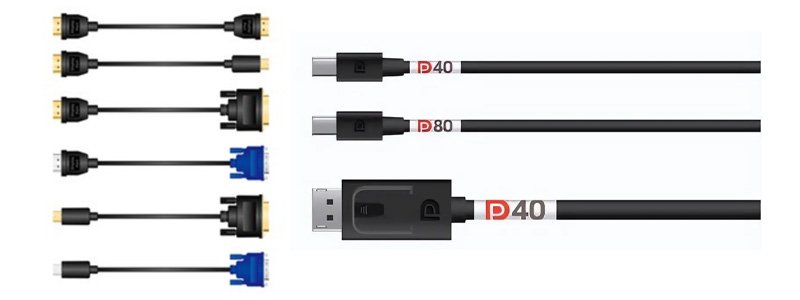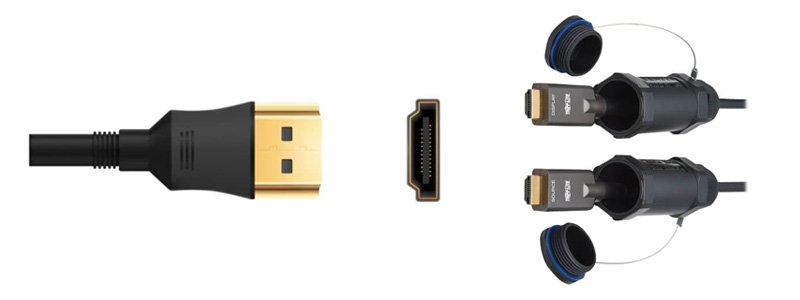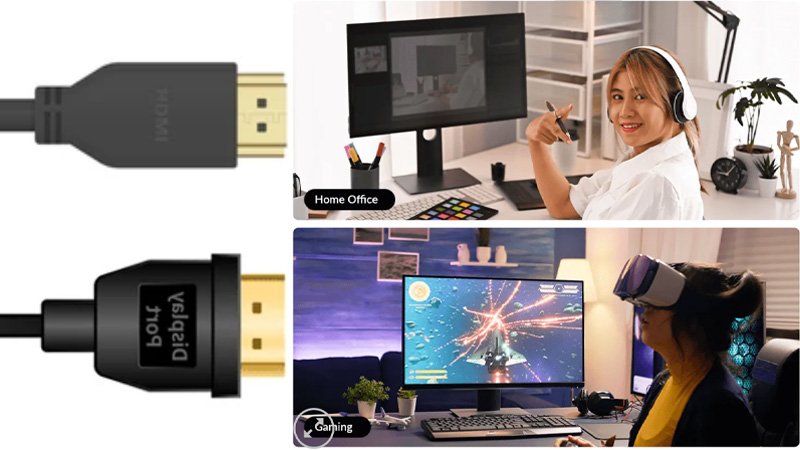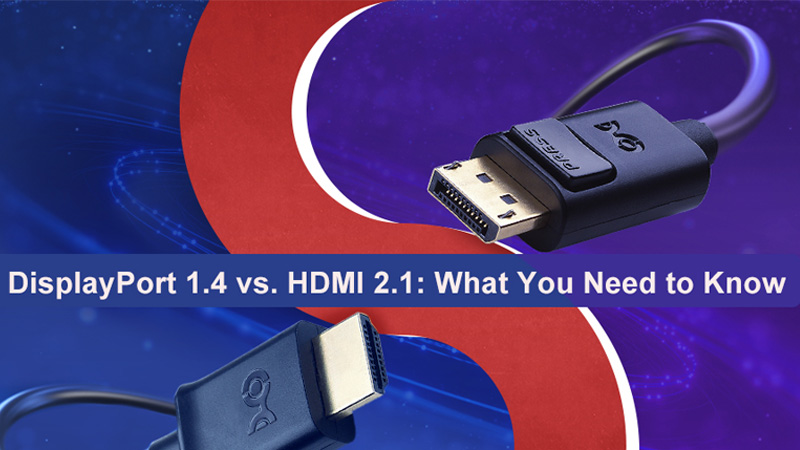Connectivity is still the key to greater efficiency. Despite the availability of remote technology, cables and wires remain relevant and, if ever, facilitate an even more excellent immersive experience through their efficiency.
Among those cables are DisplayPort 1.4 and HDMI 2.1. Let’s discuss what they offer and why they are sought after by most consumers.
1. DisplayPort1.4: Use and Specifications
DisplayPort 1.4 is one of the latest versions of Display Port, a family of cable wire technologies used to connect a particular video source to a display technology. Designed nearly two decades ago, it has dominated the market due to its broad applicability and compatibility with video sources.
Throughout the years, Display Ports of various versions were used to connect all kinds of video sources—computers, gaming consoles, and the like—to display technologies such as television sets and PC monitors.
The DisplayPort 1.4 boasts impressive specifications that can elevate users’ aesthetic and immersive experience several notches. It is one of the latest DisplayPort, and it is faster, more energy efficient, and can handle more bandwidth than its previous incarnations.
Specifications
Many consider DisplayPort’s specifications impressive because of its wide array of uses and applicability to display technologies and content. It can handle a wide range of resolutions, from those available in the early days of High-Definition to the rarest versions of HD available today.
Consider the following specifications:
- ● Display Resolution: HD, 1080P, 1440P, 4K,8K
● Refresh Rate: 30Hz, 60Hz, 120Hz, 240Hz
● Transmission Rate: The average is 25.9, but it can go to 32.4 Gbps
● Devices: It is compatible with almost all display technologies, including video walls, televisions, PC monitors, and laptops.
As impressive as the speed and capacity are, the wide range of applications might be greatly appeal to most people. Look at display resolution, for instance. With a wide range of display resolutions that it can support, DisplayPort 1.4 is compatible with most media content in the digital age.
You will have no problem showing everything from movies to fast-paced, high-resolution games to most television shows streaming on cable and internet platforms. It can also cater to live streaming from social media platforms.
Its highest resolution, reaching 8K, means it can handle the latest technology in films and games.
The wide range of refresh rates it can handle means it can handle the transmission better than its previous incarnations. Even as you go higher in resolution and lower in refresh rate, the DisplayPort 1.4 can handle them adequately.
The wide range of devices that can use DisplayPort 1.4 makes it the ideal cable connector for many. If you have various video sources and display technologies running in your domicile, having DisplayPort 1.4 will significantly help.
Considering everything, the wide range of applicability and the excellent specifications that allow it to handle various resolutions and refresh rates make DisplayPort 1.4 a darling for many.

2. HDMI2.1: Use and Specifications
HDMI2.1 belongs to the HDMI family, a cable connector that transmits high-quality video content from a high-end video source to various display monitors. Whereas DisplayPort specializes in variety, HDMIs transmit high-quality imaging for video sources, especially gaming consoles.
They can transmit all types of HD, from 1080P to the newest, 10K. That makes them a great favorite among many gamers, especially those into newer, high-end, fast-paced games. They are ideal for games requiring higher refresh rates for higher resolution and those with more bandwidth.
Specifications
The specifications of DisplayPort 1.4 are already impressive, but HDMI2.1 takes everything to the next level. Regarding transmission quality, resolution handling, and higher refresh rates, HDMI seems better in every aesthetic aspect.
Consider the following specifications:
- ● Display Resolution: 1080P, 4K, 5K, 8K, 10K
● Refresh Rate: 30Hz, 60Hz, 120Hz, 144Hz
● Transmission Rate: 48 Gbps
● Devices: High-end gaming consoles, top-of-the-line CPU, graphics card and PC monitors and laptops, high-end televisions and monitors.
In almost all aspects, HDMI2.1 is a notch higher than its counterpart. For this reason, those who want a more immersive experience through enhanced aesthetic appeal and smooth, seamless viewing would prefer HDMI 21 for their gadgets and monitors.
That is especially true for gamers, who need updated technology to have a fantastic gameplay experience. Those into competitive gaming will need all the details in the monitor and will want something to facilitate the smooth display of content from source to monitor.
The advantage of HDMI2.1 over DisplayPort 1.4 lies in better refresh rates. The refresh rate decreases as the monitor goes from lower to higher resolution. However, HDMI2.1 can support higher resolution with higher refresh rates.
In DisplayPort 1.4, the 8K resolution can have a refresh rate of 30Hz, while in HDMI2.1, it can have up to 60Hz. That is a boon for gamers who want outstanding quality and image precision without sacrificing smooth, seamless movement and pace. Gamers can have their cake and eat it, too.
However, specifications alone are not the only consideration. The technology of the video source and monitors, the nature of the display content, and a host of other factors may determine which one suits you.

3. DisplayPort 1.4 vs. HDMI2.1: Which Suits You?
Specifications describe what a particular product can offer. They also guide you on where to use it, its application, and the consumer who will most benefit from it.
At first glance, HDMI2.1 is the clear winner. It can support far higher resolutions and refresh rates than DisplayPort 1.4. However, the higher you go regarding resolution, the rarer the display technologies.
It would be best to have ideal technology, and display technologies sporting 10K are uncommon. On the other hand, video files and games in lower resolutions are very much around. Even when upscaling, it can only go as far as the medium allows and has severe limitations.
In short, save for exceptional game consoles and other games needing the highest resolution possible, HDMI2.1 offers nothing that DisplayPort1.4 cannot offer.
The wide range of devices that use DisplayPort 1.4 is more extensive than HDMI2.1. A case in point is video walls. You can use DisplayPort 1.4 for multiple screens, but you need a video splitter to use HDMI2.1, which can only support one screen at a time.
However, HDMI can tremendously benefit certain types of users and consumers. Those who need the latest gaming technology employing the highest possible specs will significantly benefit from its use.
Due to advanced technology, transmission is seamless, even with the highest resolution. You can adjust the HDR settings to optimize the gaming experience. If you need higher than 4K for your games but want better refresh rates, you can always go right with HDMI2.1.
Of course, your video source and display technology must be compatible with either DisplayPort1.4 or HDMI2.1. Some support only one, while others support both.
Therefore, the one that suits you best is the one that can optimize the content through better transmission. A cable connector to watch something and enjoy the aesthetics of having finer details and precise imaging in your display technology, then having DisplayPort1.4 might be enough.
If your display technology needs something that can handle the highest resolution available today without sacrificing much in refresh rates, then you go with HDMI2.1. You will have no choice if you play specific game consoles employing HDMI2.1.
DisplayPort1.4 and HDMI2.1 specifications are impeccable, and even in their respective families, they are among the latest and considered topnotch. What suits you, however, depends on other factors, the most important of which is applicability.
The question here is which one is best for you. Regarding transmission and other specs, HDMI may be better, but applicability and other factors are more important than specifications.
Applicability is undoubtedly king, whether you choose DisplayPort1.4 or HDMI2.1. Cost is not a factor here; the usual difference is between two and five dollars.
Given the nature of the video source, the display technology, and all the experience it can give you, it may amount to a little. However, DisplayPort1.4 is less expensive than HDMI2.1 in most retail stores.
In any case, whatever suits you, whether DisplayPort 1.4 or HDMI2.1, we at LEDSINO can be of great help. The devil is in the details, as they say. We can discuss the intricate details, minute advantages, and applicability of the two cable connectors and help you decide which is the perfect fit for you.

4. Final Thoughts
DisplayPort1.4 and HDMI2.1 are among the latest cable connectors in the market today. They are among the latest versions of respective cable connectors that have been around for the last two decades, improving on previous ones to give consumers the best transmission.
Their wide range of applicability allows them to capture a fair share of the market, making them almost household names for entertainment enthusiasts and gaming fans. Their impressive specifications transform the aesthetic experience, transcending what previous technologies can offer.
HDMI2.1 may have the upper hand concerning transmission, pound for pound. However, DisplayPort 1.4’s broader range of applicability makes most consumers take a second look, figuratively and literally, and see which one is applicable.



